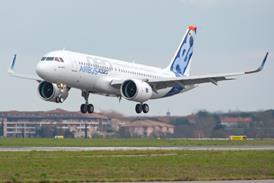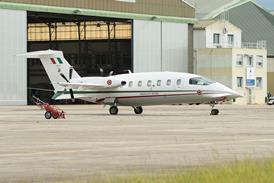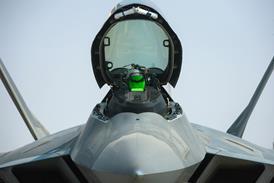GRAHAM WARWICK / WASHINGTON DC
A range of affordable new systems and devices offer to reduce the traffic, terrain and weather flying hazards facing GA and business aircraft
Technology appears to be making business and general aviation flying safer. The hazards posed by first traffic, then terrain and now weather are being tackled with systems that can improve the pilot's awareness of the aircraft's situation. The challenge faced in this market sector is how to integrate these technologies to reduce workload for the corporate and private flyer.
First of the triumvirate of safety technologies to gain widespread acceptance was the traffic alert and collision avoidance system (TCAS). Although privately operated aircraft are exempt from regulations requiring all US commercial aircraft to be equipped with TCAS, many owners have fitted the system as a precaution.
Larger business jets tend to be equipped with the full-up TCAS 2, which provides resolution advisories, while smaller aircraft can be fitted with the simpler TCAS 1, which provides traffic alerts only. Development of more affordable traffic advisory systems has expanded the market to include high-end piston-powered aircraft.
Goodrich and Honeywell traffic advisory systems are close to TCAS 1 in capability but significantly cheaper. Goodrich's SkyWatch provides an 11km (6nm) surveillance range and costs less than $18,000, while the SkyWatch HP, certificated late last year, tracks and displays aircraft out to 65km and costs $24,000. Aimed at twin turboprops and smaller business jets, the SkyWatch HP meets the requirements for a TCAS 1, says Goodrich.
Honeywell's KTA 870 traffic advisory system is about one-third of the cost of a traditional TCAS 1. The system forms part of its Bendix/King IHAS 5000/8000 family of integrated hazard avoidance systems. Earlier this year, the company introduced the KTA 970, a cheaper TCAS 1 based on the KTA 870 and using the traffic advisory system's smaller and lighter directional antennas.
While systems such as SkyWatch are available with their own displays, in many aircraft traffic information is presented on a multifunction display (MFD). Most popular MFDs - including Avidyne's FlightMax, Garmin's GNS 400/500 and UPS Aviation Technologies' (UPS-AT) MX20 - provide interfaces for several traffic advisory systems.
Package deal
Honeywell offers its own KMD 550/850 MFDs, while Goodrich has introduced the I-Linc display based on UPS-AT's MX20. Their intent is to package collision avoidance, terrain awareness and weather information with a moving map display to improve pilot situation awareness, and as a first step towards integrated cockpits for general aviation aircraft.
Collision avoidance technology is becoming more widely available as more regions mandate the installation of TCAS. In Europe, the requirement to carry TCAS 2 will be expanded by the beginning of 2005 to include all aircraft with a maximum take-off weight of 5,700kg (12,500lb), including most business jets and twin turboprops.
TCAS-type data may eventually be displayed in every cockpit thanks to the traffic information system - broadcast (TIS-B). This uplinks to aircraft the traffic picture produced by ground radars. In the USA, TIS-B is becoming available initially via the Mode S link, with plans to introduce a cheaper datalink for general aviation.
Europe's requirement for Mode S surveillance of all instrument flight rules traffic, including general aviation, has been delayed from March next year to March 2005, but has served to stimulate demand for lower-cost Mode S transceivers. Garmin, Honeywell and UPS-AT are developing Mode S units for the GA market, which could lead to expanded use of TIS-B.
Just as regulation forced the widespread adoption of TCAS, worldwide fielding of the terrain awareness warning system (TAWS) is being driven largely by installation mandates. Using a digital database, TAWS adds a predictive terrain hazard warning capability to ground proximity warning systems (GPWS).
In the USA, all new turbine aircraft with six or more seats - private and commercial - were required to be fitted with a TAWS by the end of March, with all in-service aircraft to be equipped by the end of March 2005. In Europe, all new aircraft in commercial operation with a maximum take-off weight between 5,700kg and 15,000kg, or between nine and 30 passengers, must be fitted with a TAWS by the start of next year. All in-service aircraft weighing more than 15,000kg and with more than 30 passenger must be equipped by January 2005.
While these mandates are causing concern about the availability of equipment, they have served to attract additional suppliers to the market. Honeywell, original developer of the enhanced ground proximity warning system (EGPWS), now faces competition from companies including Goodrich and Universal Avionics Systems
In the USA, the TAWS has been divided into two categories: Class A and Class B. Commercial operators of aircraft with 10 or more seats, whether airline or air taxi, must fit the full-up Class A system, while private and commercial operators of aircraft with six to nine seats can fit the simpler Class B TAWS, which does not require a display.
Certificated Class A systems are available from Honeywell and Universal. ACSS, a joint venture between L-3 Communications and Thales, plans to certificate its traffic and terrain collision avoidance system (T2CAS) by year-end, with shipments to begin early next year. T2CAS combines a TCAS 2 with a Class A TAWS and is a direct replacement for the company's TCAS 2000, already fitted to larger business jets and airliners.
In April, Sandel Avionics received certification for its ST3400 TAWS, which provides Class A and B functionality and is a drop-in replacement for a panel-mounted radio-magnetic indicator (RMI).
Including liquid-crystal display (LCD), the self-contained unit is housed in the same 3ATI package as a standard 75mm (3in) cockpit instrument. LCD projection technology provides a viewing area equivalent to a 100mm instrument, Sandel says. The initial target market is business jets.
TAWS recognition
While the Class B market accounts for around half the 18,000 aircraft that must be equipped in the USA, in Europe and elsewhere there is no recognition yet of the simpler TAWS. But that could change, expanding the market still further.
Following its success introducing TCAS technology to the GA market with the SkyWatch, Goodrich is developing the LandMark Class B TAWS. Due to be certificated later this year, the LandMark is a remote-mounted unit that is available either as a standalone system or with a terrain display. The unit will interface with established MFDs, including Goodrich's new I-Linc.
Honeywell offers a Class B TAWS on its own or combined with either a terrain advisory system or TCAS 1 as the KMH 880/980 multi hazard avoidance system. Demand for the combined system has outstripped that for the standalone unit. "About 80% of customers get the combination," says Dan Barks, director of marketing for business, regional and general aviation. "Everybody likes traffic, and needs terrain."
To meet the TAWS mandate, other MFD suppliers are offering interfaces with available systems. Avidyne's FlightMax offers an interface with Honeywell's EGPWS as well as its own non-TAWS terrain display. UPS-AT's MX20 ties into both the Goodrich and Honeywell system, as well as providing its own non-TAWS terrain, while Garmin has yet to decide what route to take. "It's on the radar. We may self-develop," the company says.
The third element of the safety technology triad - graphical weather - is beginning to make major inroads into the GA market without the benefit of a regulatory push. One reason is the obvious operational benefits of in-flight weather updates via datalink. Another is the growing number of competitors offering alternative means of delivery.
Uplinked weather is not new to operators of larger business jets, who can receive graphics via VHF datalink or satellite communications using Honeywell's AFIS airborne flight information service or Universal's competing Unilink. Now similar services are becoming available for smaller aircraft and providers are eyeing expansion beyond the USA.
Graphical weather
Arnav Systems and Honeywell were selected by the US Federal Aviation Administration to build and operate flight information system - broadcast (FIS-B) networks providing graphical weather, initially Nexrad radar images, directly to GA cockpits via VHF datalink (VDL). Honeywell's WxSight ground station network "is fairly complete east of the Rockies and we are working on the west", says Barks. Between 300 and 400 aircraft are equipped with VDL Mode 2 radios.
The aim of FIS-B is to provide a basic text weather service for free and offer graphical products for a subscription fee. "The service is not encrypted yet, so everything is free. We may extend that into the fall then charge a base $50 a month," says Barks. The system provides frequent updates of 4km-resolution Nexrad weather-radar images of the continental USA.
"People are happy with Nexrad," Barks says, but plans call for additional products such as icing forecasts and winds aloft. The most requested services are lightning reports and the replay of stored Nexrad images to show weather movement. "We can do that now," he says. Honeywell would like to expand the service into Europe, but faces hurdles with frequency allocation and the commercial availability of suitable weather products.
AirCell is moving into the datalink weather market using its airborne cellular-telephone system. The company's FlightGuardian weather service uplinks Nexrad images for display on MFDs, electronic flight bags or even hand-held personal digital assistants (PDAs). AirCell provides the datalink for Control Vision's Anywhere Wx software, which overlays radar images on a moving map running on a Compaq iPAQ PDA. UPS-AT will use AirCell's FlightGuardian service to provide graphical weather to users of its MX20 MFD. Downloading a Nexrad radar image via takes a 1min phone call - slower thanFIS-B, but affordable, say the companies.
The growing number of satellite-based weather service providers argue they offer coverage at all altitudes that terrestrial systems cannot match. First on the market was Echo Flight, which has been providing a datalink weather service via Orbcomm low-Earth orbit satellites since 1998. The company says it has "several hundred" subscribers and expects this to increase to "several thousand" under an agreement to offer the service via Garmin.
Broadcast service
Echo Flight is a two-way request and reply system, Nexrad images being transmitted in response to individual pilot requests, and subscription rates depend on the number of images per hour required. This is being developed into a broadcast service for Garmin, which will begin shipping its GDL 49 satellite datalink radio in July. Echo Flight, meanwhile, is expanding its services include terrain contours, Landsat imagery, restricted airspace and additional weather products.
After flirting with Echo Flight, Avidyne decided to develop its own Orbcomm-based weather service. Deliveries of the DX50 datalink radio are to begin in August and the company says: "We will be the content provider." Unlike request/response Echo Flight, which can involve delays of several minutes, the service will be "narrowcast" - weather updates will be broadcast at regular intervals based on individual flight plans supplied to Avidyne.
True broadcast weather via satellite will become commercially available in the USA in July and in Europe by year-end, through Satellink Technologies' Merlin service. The company will broadcast weather images and other information via L-band link using a Mobile Satellite Ventures geostationary satellite covering the USA and Worldspace's Afristar over Europe.
The company is "working with all the MFD suppliers", says chief financial officer Marty Mosier. UPS-AT has agreed to make Merlin available on its MX20 later this year and Jeppesen will offer the service on its electronic flight bags, he says. Boeing subsidiary Jeppesen is providing worldwide weather products for Merlin. Leading weather information provider WSI also plans to offer a similar satellite broadcast service following its acquisition earlier this year of Pilot Weather Advisor.
Source: Flight International























